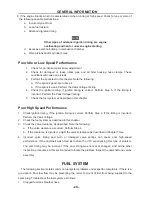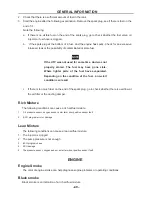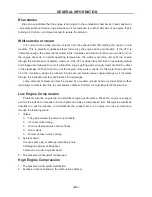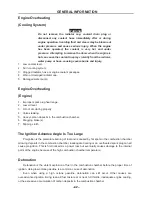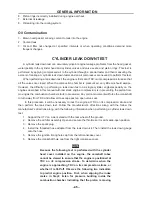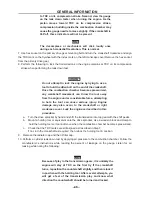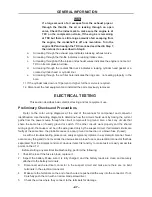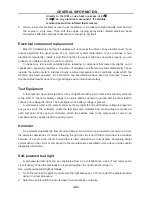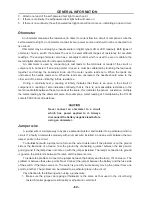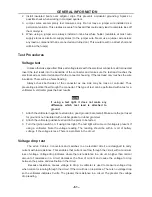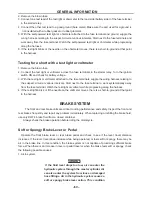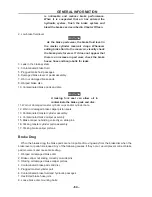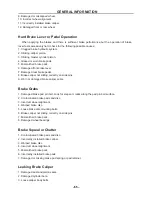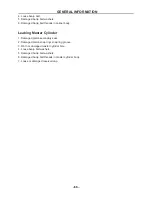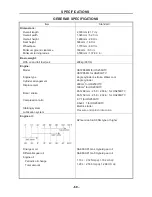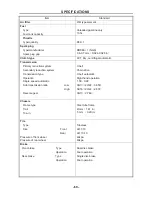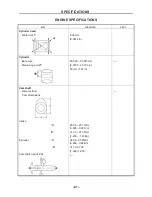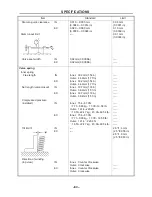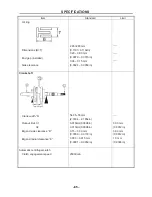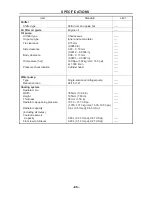
-52-
GENERAL INFORMATION
- 52 -
To perform a voltage drop:
1. Connect the positive meter test lead to the electrical source (where electricity is coming from).
2. Connect the voltmeter negative test lead to the electrical load (where the electricity is going).
3. If necessary, activate the component(s) in the circuit. For example. If checking the voltage in the
starter circuit, it would be necessary to push the starter button.
4. Read the voltage drop (difference in voltage between the source and destination) on the voltmeter.
Note the following:
a. The voltmeter should indicate 0 volts. If there is a drop of 0.5 volts or more. There is a problem
within the circuit. A voltage drop reading of 12 volts indicates an open in the circuit.
b. A voltage drop of 1 or more volts indicates that a circuit has excessive resistance.
c. For example, consider a starting problem where the battery is fully charged but the starter motor
turns over slowly. Voltage drop would be the difference in the voltage at the batter (source) and
the voltage at the starter (destination) as the engine is being started (current is flowing through
the batter cables). A corroded battery cable would cause a high voltage drop (high resistance)
and slow engine cranking.
d. Common sources of voltage drop are loose or contaminated connectors and poor ground
connections.
Peak voltage test
Peak voltage tests check the voltage output of the ignition coil and ignition pulse generator at
normal cranking speed. These tests make it possible to identify ignition system problems quickly and
accurately.
Peak voltage tests require a peak voltage adapter or tester. See Chapter Ten, Ignition System
Testing.
Continuity Test
A continuity test is used to determine the integrity of a circuit, wire or component. A circuit has
continuity if it forms a complete circuit, that is, if there are no opens in either the electrical wires or
components within the circuit. A circuit with an open. On the other hand, has no continuity.
This type of test can be performed with a self-powered test light or an ohmmeter. An ohmmeter
gives the best results. If using an analog ohmmeter, calibrate the meter by touching the leads together
and turning the calibration knob until the meter reads zero.
1. Disconnect the negative battery cable.
2. Attach one test lead (test light or ohmmeter) to one end of the part of the circuit to be tested.
3. Attach the other test lead to the other end of the part or the circuit to be tested.
4. The self-powered test lead comes on if there is continuity. An ohmmeter reads 0 or very low
resistance if there is continuity. A reading of infinite resistance if there is continuity. A reading of
infinite resistance indicates no continuity, the circuit is open.
Testing for a short with a self-powered test light or ohmmeter
1. Disconnect the negative battery cable.
Summary of Contents for HS200UTV
Page 3: ......
Page 15: ......
Page 94: ... 79 SPECIFICATIONS 79 HYDROGRAPHIC CHART Hydrographic chart Pressure ...
Page 95: ... 80 SPECIFICATIONS 80 LUBRICATION OIL WAY LUBRICATION OIL WAY Pressure splashing oil ...
Page 248: ... 233 CHASSIS 233 Fuel tank cap Remove the fuel tank cap by turning it counterclockwise ...
Page 263: ... 248 ...
Page 304: ... 289 ...
Page 305: ... 290 ...
Page 306: ... 291 ...
Page 307: ... 292 ...
Page 308: ... 293 ...
Page 309: ... 294 ...
Page 310: ... 295 ...
Page 311: ... 296 ...


